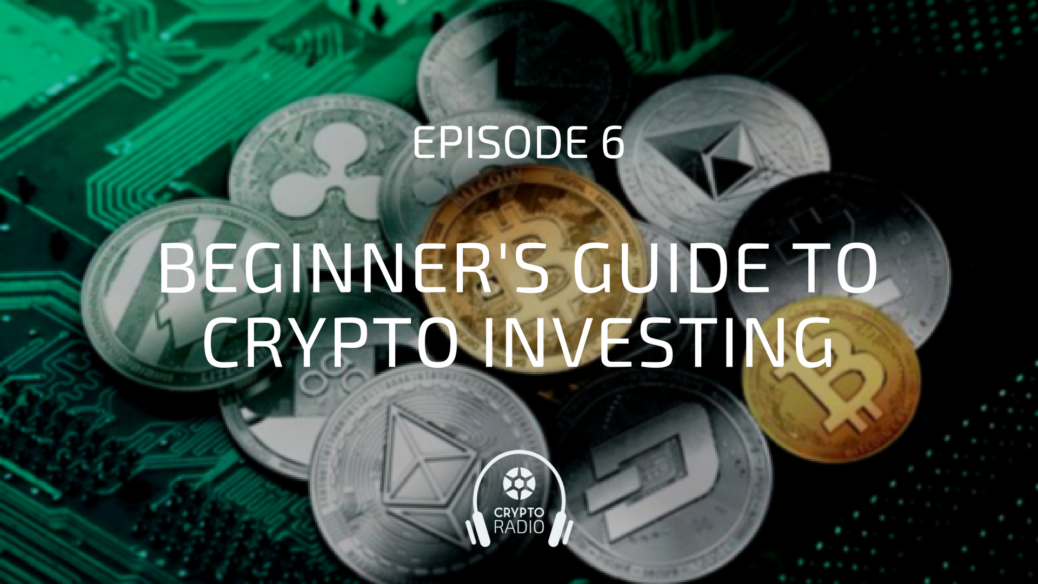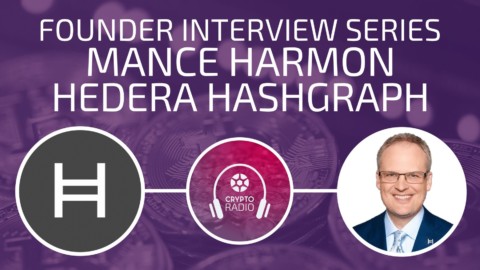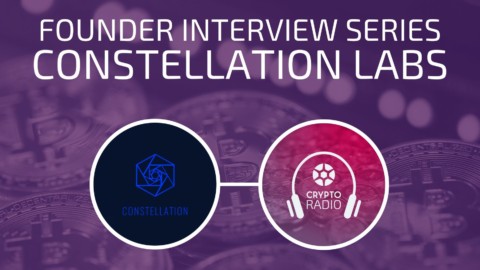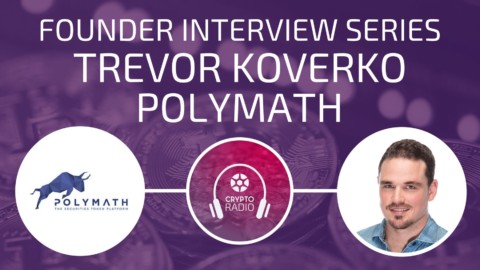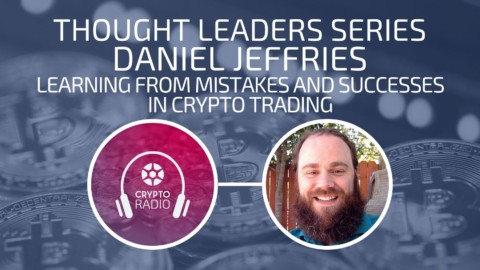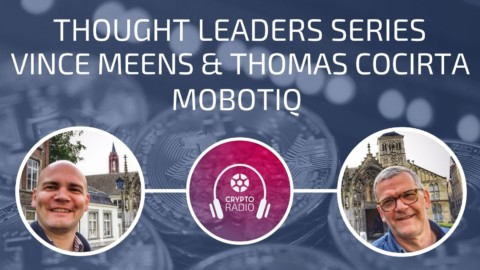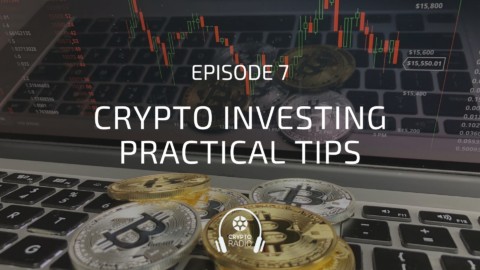Podcast: Play in new window | Download
Mike: Welcome to Crypto Radio. We interview the top thinkers and entrepreneurs in the blockchain and cryptocurrency industry. We also cover topics like trading, investing, and ICOs. We’re your hosts, Mike Gilliland, Michael Paul, Chris Sparks and Euvie Ivanova. We’re entrepreneurs, crypto investors, and co-founders of a new blockchain investment platform cosyndicate.io. We created cosyndicate and Crypto Radio to make crypto investing a better experience for you. [00:00:30]
[00:01:00] Chris: So, I would approach it, obviously depending on their experience with investing and other sort of markets, so maybe they’ve invested in the stock market or with other sort of funds and kind of compare our cryptocurrencies, you know, looks like from that perspective. If they have no investment perspective, then really, they shouldn’t be investing like in too high-risk things like ICOs, but they can just sort of hold fairly safe sort of coins like Bitcoin or Ethereum, you know, if they want to have some exposure. So, I kind of talk about [00:01:30] in portfolio management.
That’s how I break it up in terms of the theory and these sort of conceptualization, and then the actual execution in terms of how you buy the coins, that is quite technical still so they may need some sort of help and support with that. But we’ll be providing resources anyway along the way. So, if I just explained to people, you know, how cryptocurrencies look at the moment, you know, we have half a trillion-dollar asset class. So, there’s about 500 billion dollars’ worth of value stored right now in cryptocurrencies, and we mentioned before, you know, Bitcoin is around half of that at the moment. So, half the market is Bitcoin, and half the market is all these other alt coins which [00:02:00] are, you know, Ethereum, Litecoin and all the smaller ones.
So, the way I look at it, you know, is obviously cryptocurrencies is definitely very speculative investment, something that’s very new and emerging. It’s not regulated, it’s not well understood by most people. So, it looks like it’s just going up and up and up and that’s great, but obviously anything that has a lot of return tends to have a lot of risk. That is, like, traditionally how investors look at risk return. So, you have to decide how much are you willing to put at risk in order to get the return you’re looking for. And I think risk tolerance is different for everyone, so that’s really an individual, you know, consideration.
[00:02:30] But, obviously, if something’s going up a lot there’s obviously a chance it comes down a lot too, and it’s very common for people to get excited and buy in at the top. When they’re hearing about, you know, Litecoin going to new highs on CNBS, that maybe is not the best time to be buying something because there’s always a good chance it’ll turn around and go down. And the volatility with this market is obviously very high, because it’s just normal, right? The price is going to move around a lot, there’s a lot of people coming in, a lot of new money trying to get in.
But also, a lot of scared people and new investors who can get panicked very easily. If I talk about cryptos at that high level, I would say you don’t actually need to put a lot of money into it to get a good return, because everything’s [00:03:00] moving so fast. So, I don’t say, you know, you put all your net wealth in overnight. But if you had, you know, even 5 percent of your savings stored in cryptos and I think you’ll look back a year or two from now, you’ll be very, very happy you did that. And for most people, that’s an amount they can afford to lose, they don’t even have to think about it, they wouldn’t be checking their portfolio every day or, you know, staying up at night struggling to sleep.
Whereas, if you jump in and put, you know, half of your savings into cryptos, you may not have the stomach for that, it may be too volatile. So, that’s the first thing I would sort of preface, that you don’t actually need to put a lot of money at risk, because the market’s moving up so quickly at the moment, and that’s pretty much how I got started, you know. I put a very small amount [00:03:30] in. As I started to educate and inform myself, I gradually put more and more in because I was more comfortable with what I was investing in.
If you perceive something as risky, it’s usually because you don’t understand something. And once you understand it, you can actually understand where the risks are in that market and how to mitigate against them. So, I’m not going to go too deep into all those sort of investment strategies I do, but, you know, the high level working out what you’re comfortable to put at risk and then, let’s say you have you know $100,000 savings, you decide to put 5 percent in. How do I put that $5,000 at work in cryptos? What’s the best sort of risk return within the crypto markets?
[00:04:00] So, that’s what we’re going to talk about today, and hope that’s helpful for some people. So, if we take that, you know, like I said the half a trillion dollars right now in market cap across cryptocurrencies, obviously most of that’s in Bitcoin, 50 percent, so I think that’s traditionally perceived to be the safest investment in terms of it’s been around the longest, you know, it’s the most tried and tested. It’s got the most trust just based on the market cap, right? That’s what the free market has voted for as the most sort of safe currency. But you also have the sort of top 10, 20 coins, which have also been around for a while.
They have, you know, big dev communities, obviously a lot of value and trust stored there, as well. So, they now have, you know, [00:04:30] five, six-billion-dollar market cap valuations. These are not small companies anymore. And I think these are also considered fairly safe, you know, as far as within cryptos go. So, this is not a bad place for a new investor to start looking, because these coins are not going to go to zero overnight. They are still obviously very new and there’s obviously risk, but I think within cryptos it’s probably the safest part of the market to be.
And then you have the sort of junior alt coins, which is what I refer to as anything as sort of top 200, 300, 400, 500. So, these can be, you know, $50, $100 market cap coins. These ones are obviously a lot more experimental, [00:05:00] haven’t been around as long, but they have a lot of potential because they’re a new project solving new problems. And if you get in on the right ones and you understand the problems these coins are solving then you can do very well, because they can double and triple very quickly. So, I’m not going to promise any kind of returns, I’m just telling you that risk return spectrum, that’s how it looks within cryptos. You have the sort of top 10, 20 which are more stable and they’re still growing very fast compared to traditional investments. But then you have sort of mid-tier market like mid-caps, small-caps, which are the junior alt coins as I referred to them.
So, the best way to try and understand this is like, what are the problems these coins are solving? [00:05:30] Because if you look at that, you’ll have a better idea at what the potential value is if they solve those problems. So, you know, Bitcoin is obviously solving a big problem that we’ve talked about in terms of transfer of value without the middle men, without the inefficiencies, without the waste. And so, people have just decided to use it and spend it and transfer value that way. There’s other sort of use cases like privacy coins, people want to transfer anonymously, using Monero and coins like that. Which, you know, obviously give them protection.
So, there’s many different use cases and many different problems that are being solved. If you focus on one of the biggest problems, you’ll typically find the coins that will have the biggest potential returns. [00:06:00] And so, that does require a bit of understanding of finance and what this economy looks like in terms of cryptocurrencies, what are the problems that are being solved, and who’s tackling that. And then you’re trying to understand who are the teams behind these projects? How credible are there? How developed experience do they have? You know, what’s their pedigree and what are they really trying to do?
What’s the sort of road map for these projects? A lot of the, especially the lot of junior coins, they’re very speculative because they’re so new, and there’s a high chance a lot of them won’t be around, you know, in a few years. So, you have to come into it with that understanding, as well, that you’re not going to necessarily see all these companies around in a few years. [00:06:30] There’s going to be so much change and evolution and disruption within the industry, as well, and so not to get too attached to one position, spread your, you know, portfolio around in terms of diversification.
I personally don’t have more than 10 to 20 percent of my crypto portfolio in any one single coin, just because I have no idea which ones are actually going to be the ultimate winners and how’s it’s going to, you know, evolve in the next few years. So, I think that sort of top 10, 20 by market cap, that’s a very safe place to start. You have to buy Bitcoin and Ethereum anyway right now, and Litecoin you can get as well in some exchanges. So, when you’re converting your Fiat money, [00:07:00] you know, your currencies like your pounds and your dollars, those are really the only ones you can buy anyway straight away.
And then once you have Bitcoin and Ethereum you can start to get into the rest of the coins. And that’s actually a good thing, because that’s the least risky place to park it for now, until you have done the research to inform yourself and educate yourself. So, that’s the sort of broad overview, and then you have ICOs, I mean, obviously more risky strategies that are at the higher end of risk return. But, like I said, I wouldn’t recommend that to people unless they’re already sort of professional investors.
Chris: Yeah, absolutely. I think it’s a really good place to start. I’m trying to think from the perspective of a first-time investor [00:07:30] grandma example. What do you say to people when they say, “Well, yeah, well Litecoin,” what is Litecoin right now, like 700 or so? Like, “It’s so expensive, I missed the train on this.” What do you say to people who have that sort of mentality or perspective on getting into the game?
Michael: Yeah, it’s really funny, I think a lot of people have that perspective. You know, Bitcoins at $20,000 almost right now and people are saying, you know, “I kind of missed it, I can’t buy a whole Bitcoin.” The first thing you need to look at is actually the market cap, not the price of the coin, because it’s very misleading. Some people feel like, you know, Ripple’s very cheap because it’s less than a dollar per Ripple coin. [00:08:00] But there’s like so many Ripple, the market cap is huge already. So, it’s one of those sort of safe coins in terms of it’s got a huge market cap, it’s not necessarily going to double and triple very quickly. You might get better returns investing in a smaller coin.
So, you shouldn’t just buy based on the price of the coin, that’s the first thing. Always look at the market cap and, obviously, look at the use case like what problem is it solving. But in terms of are you too late, this is just so early, right? Less than one percent of people own cryptos. This is like just getting started. If you believe this technology is going to takeover a lot of finance, then there’s a multitrillion dollar industry. [00:08:30] You know, we have people worried about bubbles and say Bitcoin’s in a bubble, but we have, you know, half a trillion dollars of cryptos. You compare that to other asset classes, you know, you have eight trillion dollars in gold, no one’s worried about gold being in a bubble. So, they’re perfectly happy to park their money in gold as a saving, and that comes down to what your understanding is, what I was saying about risky, right?
If you think something’s risky, it’s usually because you don’t understand it. And most people think they understand gold, so they’re quite happy to park their money there, because they think it’s a good saving, you know, a good store of wealth. But you can look at other asset classes like global property, there’s about 200 trillion dollars in asset value. [00:09:00] Global stock market’s about 50 trillion dollars. Government debt is 100 trillion dollars. These are all huge bubbles, right? Within the dollar, within the Fiat monetary system. So, if you compare that to cryptos, which is less than half a trillion dollars, so, you know, round that number right now and obviously it’s growing very fast, then this is such a new, new market and we’re very, very early stages in terms of adoption.
So, very few people have it, and when that public awareness spreads like we saw with Thanksgiving, everyone started talking about cryptos because, you know, obviously they get together at family time and they talk about these things, then suddenly public awareness grows and picks up. You see all these headlines [00:09:30] and, you know, in the newspapers about cryptos and it’s all over CNBC. Like, this is just getting started now. So, if you look about a year or two from now I think you’ll feel the same way that you got in too late, but it always feels like that.
Chris: Yeah, people have been saying, “I’m too late to get into Bitcoin,” since it was at like $30, right?
Michael: Yup.
Chris: So, it’s almost comical at this point to perpetuate that. I guess the risk of not getting in at all is, it’s something you want to avoid more than actually losing 5 percent, for example, of your wealth. You don’t want to wake up [00:10:00] in 2020 and say, “I wish I got into Bitcoin when it was at $20,000.”
Michael: Yup, yup. I mean, it’s gone really crazy this year just because of that sort of exponential growth and public awareness. And obviously the other big change from this market to other markets is traditionally in finance, you know, the big investments, big money gets in first like institutional investment. And then as that product matures and as the market matures, that gets offered to retail investors, so that’s always it’s worked in our lifetimes and this is the first set of asset or industry where new money getting in is actually, [00:10:30] there’s retail crowd, you know, the novice investors and developers and the technical people.
And now institution money is just starting to be able to access it because they haven’t even been able to buy in until now, you know, there’s not regulated market or exchange for them to get to it and so now we have Bitcoin, Future’s launching on the CME which is one of the biggest exchanges for institutional money. This is going to be the wave of capital coming in from the, you know, big money funds, big money markets that haven’t been able to access cryptos before. So, these are all the people holding trillions in stocks and bonds and property and looking for ways to get better growth, because all those industries aren’t growing very fast.
So, this is a completely different market [00:11:00] you’ve got to spin it on its head totally, in terms of, you know, where we are, where we’re going.
Chris: Where we’re going right now is moving, like you said, from retail now into institutionalized investment, but the concerns remain I think in the public conversation and public discourse about what are the cycles that are going on here with regards to height and misrepresentation actually of the value of the industry as a whole. What part of the hype cycle are we actually in right now would you say?
Michael: Yeah, so I think within the market there’s different sort of sectors. So, like, the ICO market we’ve seen a lot of hype in [00:11:30] Froth and then a big wash out where, you know, they all lost a lot of value. And now the confidence is kind of coming back in for another wave of sort of fundraising, but it is very saturated, there’s a lot of scams and fraud. And just start ups with high risk. So, I think we got to separate that out from cryptocurrencies in general, in terms of how risky our cryptocurrency is. So, you’re looking at where we are in the cycle, like I was just saying, you know, public awareness is tiny.
So, not only is institutional money just getting in but actually most of the public is just getting in. So, we’re like in a very, very early stage of adoption, a long technology curve. And I think that if [00:12:00] you compare this to other bubbles, like people say, you know, “This is like the dot com bubble or something.” The dot com wasn’t really competing with the dollar, it wasn’t really competing fundamentally as, you know, a claim on energy. So, I think it’s really important to step back, because most people don’t actually have a good understanding of money and finance, and what currency represents. And this comes back to, you know, what we have now, what we’ve grown up with.
Like, we’ve all been born into a system where the dollar and Fiat currencies are the ones that are trusted and have the value. And if you understand why that’s the case, obviously governments are issuing that and there’s some confidence in government’s ability to, [00:12:30] you know, maintain that system and collect taxes. And, you know, ultimately all it’s doing is a representation of a claim on energy. So, it’s like I can take this dollar and I can get something else that has value, and that took energy to create.
So, it’s this sort of abstraction of energy and all the sort of investments we make in property or like, you know, the dot com bubble. They weren’t really trying to replace that or change that, they were just speculations on specific technology becoming more popular and widespread. So, this industry obviously has similarities and there is some analogies in that the technology is new and it’s disruptive [00:13:00] across many sectors, but fundamentally, cryptocurrencies is also competing with the dollar and Fiat currencies as a better claim on energy, because it’s more trusted, it’s less susceptible to fraud and corruption.
And that’s the big problems in the finance world today, so I think take a step back you’re measuring Bitcoin and dollars, but actually that may not be the best way to measure it because dollars are at this point losing faith and confidence every day.
Chris: Yeah, definitely.
Michael: Yeah, I’m going a bit too deep maybe, but I think it’s good for people to understand how to measure the value of something and what is something. You need to understand what is it doing, like, it’s solving a problem. [00:13:30] And what is the problem, right? The problem is that the dollar is fundamentally the best system we have today, but it’s not a very efficient system because it’s got lots of counter party risks, there’s lots of debt. There’s lots of bubbles within the dollar within all these asset classes, which cryptocurrency doesn’t have because it has no counter party risk. So, it’s actually a great way for institutional investors to hedge their risks, and that’s one kind of use case for why they’re going to jump in when the Future launches for the public, obviously, they’re going to see some growth so they can’t find another asset.
So, they’re going to speculate and they probably don’t understand what they’re investing in. But I think if we try to separate who we’re trying to help, you know, [00:14:00] obviously this shows not so much for institutional investors, more for the retail investors. What do they need to know about what the trends are, what’s coming? So, I think if they understand like that sort of broad overview of what is money, how we’ve grown up with money, to understand what it is. And maybe most people don’t actually have a full picture of what money is, tangible, intrinsic value. It’s pretty much whatever people agree has value, but also, you know, current systems are pretty much enforced.
Like, you have to pay your taxes in Fiat dollars, you have to earn your income in Fiat dollars, so that actually creates a demand for a currency that otherwise wouldn’t be there. And when people can choose what to store value in, they will [00:14:30] probably choose something that is less likely to be corruptible. So, we talked about the human element before, you know, that counter party risk of the banks, and all the people managing the finance world for hundreds of years, they obviously have self-interest. And they don’t always do what’s in the best interest for us in terms of our value. So, when we earn money with our jobs and our labour, we’re trying to store it and protect it and make it last. And, you know, even make it grow and that’s not really the same interest as the people who are issuing the currency have.
They have very different interests. So, I think people will choose a currency that is more aligned with their interests, and Bitcoin just tends to [inaudible [0:14:59].5] because it’s not corruptible, hasn’t got that [00:15:00] counter party risk, that’s pretty much the main benefit of cryptocurrencies that I’m trying to help, you know, people understand.
Chris: For the sake of this conversation, we’re positioning cryptocurrencies as, from an investment perspective a hedge against the dollar and from a technological perspective the evolution of money, correct? So, I’m thinking in terms of milestones and one of the ones that always comes up in my head is transaction throughput of cryptocurrencies compared to, for example, visa as far as scaling and adaptability. [00:15:30] When do you think that that could be possible, just so that we can, I know that there’s certain investing but I wanted to talk about the tech a little bit so that we can just at least plant the seed of thinking about this in people’s heads. When do you think we would be able to see sort of, you know, the same sort of volume that’s going through visa going through crypto?
Michael: Yeah, so I think that, you know, public blockchains, they have their drawbacks, as well, obviously like you’re saying speed and scale is a problem. There’s a number of companies trying to solve that with, you know, slight chains and state channels that can handle much faster transaction volumes, especially in the financial world that’s necessary, you know, [00:16:00] which can’t happen right now in public blockchains. So, there’s a lot of evolution in the space, again, it’s hard to know who’s going to win. But it’s just like looking back, you know, when we had the first automobile and suddenly transport was disrupted right. You look back then at the first set of cars, their fuel efficiency was terrible, right, it was horrible.
You wouldn’t be bale to do now what you can do, you know, 40, 50 miles to the gallon. So, in the same way, what we have now is like the very crudest, earliest form of the automobile and we don’t know where it’s going to be in 10, 20 years. But if it keeps evolving at the pace that it has been at the moment I think it’s going to happen, [00:16:30] you know, very quickly that will be able to support very, very high throughput, maybe not even with blockchain technology but there’s other projects like Hash Graph that use other consensus algorithms. So, this whole space is just growing so quickly, it’s very hard to say how long it’s going to take. There’s all kinds of modelling about, you know, the value of Bitcoin, where it should be based on, you know, how much people are using it.
There’s just different ways of looking at it. I think I’m not so worried about the evolution, I think it will come with the amount of innovation and brain power that’s coming into the space and, you know, that’s just something that comes with any industry. It’s obviously very early stage, it’s not very efficient [00:17:00] in some aspects but it’s a lot more efficient than what we have in the Fiat monetary system. So, that is where the demand is coming from right now, and I think there will be a catch up in terms of, you know, actual delivery and executions on some of these promises.
Chris: It just occurred to me that actually scaling the automobile and the innovation of flight actually occurred around the exact same time within plus or minus 10 years. It’s, you know, 70 years ago, or 60 years later we’re walking on the moon. Even less than that.
Michael: I don’t think we’ll have to wait that long. I think if you look at, yeah, like you’re saying the automobile, [00:17:30] you know, these technological revolutions get quicker and quicker so the industrial revolution, you know, took a lot of time like you said, but we had the internet revolution, we had the sort of smart phone revolution and this technology cycles are just getting quicker and quicker. So, blockchain is actually just one of these several exponential technologies. If you look at, you know, AI, robotics, 3D printing, car computing, [inaudible [0:17:48].3] things, these things are all actually converging. And blockchain is just a way to actually transfer value between all these systems more efficiently. So, blockchain is almost like the underlying layer enabling this huge wave of growth, and I think they’re all going to kind of converge. [00:18:00] So, it’s a really exciting space to play in. I don’t think we’re going to have to wait 50 years.
Chris: But let’s get back onto topic a little bit with ICOs. We discussed in the last episode what an ICO is or, at least, I said what I thought an ICO was. Maybe, Michael, you can tell us what is an ICO from your investment perspective.
Michael: Yeah, so if you think about how companies raise funding for their projects traditionally they, you know, usually issue shares to get a capital. So, they give up a piece of the company to investors, and then they’re listed on the stock market and retail investors can buy, [00:18:30] and that’s how they raise funds, you know, to get capital to start their businesses. Essentially, ICOs is a similar kind of intention, you’re trying to raise funding for your project but you can do it in a way that doesn’t require you to give up ownership, or, you know, equity essentially in a company. So, you’re giving people a right to use your platform and the people who are speculating that that platforms going to become more valuable will know that that token will actually increase in value.
So, that’s where they can get in and get in very early, but essentially you still own the company, you still own the direction of your project. So, you don’t have to dilute your ownership. And, you know, with other sort of fundraising [00:19:00] like, angel investors or VC funding, it’s the same thing. You typically have to give up a lot of your equity at the beginning, and that maybe not be the best thing for your company down the right. you want to maintain that but still get enough funding to do what you want to do.
So, it’s a better funding mechanism for companies, and you can argue whether it’s better for investors. I think not many investors are comfortable with it yet, because they’re used to the more traditional methods. But, you know, it essentially decentralizes and democratizes that process so anyone can invest at any stage, you don’t have to wait ‘till it’s regulated approved, you know, for you to invest as a retail public you can invest very early and [00:19:30] if you see value where no one else does you can capitalize on that and no one can really stop you. So, that’s great. The market is evolving quite quickly, I think we’re seeing a lot more regulation come in, like companies, you know, having to refund their ICO funds to certain countries where the US and China are cracking down and they can’t be seen to be soliciting funds.
So, I think from a legal perspective it’s a very grey area. It’s not that the countries themselves are saying you can’t invest, I don’t think as an investor you are breaking any rules. It’s that the companies who are using ICOs to fundraise are very wary of people [00:20:00] coming after them, governments coming after them to try and say, “Hey, you broke the rules.” So, it’s actually becoming harder and harder for retail investors to get in now because there’s more money in it and there’s more attention.
But that’s, you know, that’s just the name of the game. There’s always evolution, there’s always opportunity. And where the market’s evolving too narrow is arguably better, because it’s easier to spot scams and frauds, there’s more websites, there’s more self-governance now than there was a year ago and obviously a lot more money coming to the space so it’s still growing massively.
Chris: So, it’s really interesting to see the sheer volume of regulatory arbitrages being committed [00:20:30] by some of these ICOs in that they’re trying to attract investors from, for example, Europe where there’s not a lot of sort of control or a perceived future of control by governments upon investing in these things. Just so we can be clear, a lot of ICOs will actually put in the beginning of their ICO like, “No American investors, no Chinese investors.” And, of course, that’s not stopping anyone because you can use a VPN.
Michael: I would say that’s the case more and more, that they’re actually getting stricter with the KYC. So, KYC is know your customer [00:21:00] and often these ICOs will also have a process where you have to upload your passport, show your proof of residency and citizenship to be able to participate, and I think that’s going to become the normal standard and, you know, the next few months from now. So, that’s what I’m seeing in the space, obviously emerge and evolve, and there’s also opportunities now that are only open for institutional investors because they’re so worried about soliciting funds when the retail public.
So, it does limit somewhat your opportunity. But if you get into the space and you find, you know, interesting projects, there’s still so much opportunity. I think the governments are really going to struggle to keep up with this, they’ll always be one step behind. And there’s no [00:21:30], effectively no way, to really stop people. You know, in my investment group we have a lot of Americans and, you know, they’re still able to invest in ICOs. So, there’s always opportunity, you just have to be motivated to educate yourself and find out how to get involved.
Chris: Yup. So, Michael, like one of the questions that people always ask me is like what are the things to look for in an ICO that would trigger a decision moment for me, either to invest or not invest? What do you look for like really sort of, maybe it’s like the top 5 or 10 things that you look for in an ICO to make a decision [00:22:00] on whether it’s worthy or not?
Michael: Yup, sure. So, we actually did a recording on this, we’ll link to that as well. But just at a high level, you know, with ICOs, like I said, it’s very high risk so you shouldn’t put in more than you can afford to lose within that sort of five percent I said, you know, for your total crypto portfolio this would be the smaller percentage of that. Because for most people, they’re not professional investors. But just to kind of explain how I look at the space, because I think it might be interesting for some people, you know, I first of all look at what problem they’re solving. Because, like I said, I don’t really invest in stuff I don’t understand.
So, my background is more in finance, so I like at FinTech [00:22:30] and Protocol Layers specifically, and I don’t really invest in other things like medical blockchains, you know, science blockchains or just things like tourism. There’s hundreds and hundreds of sectors, if you can’t understand the problem you shouldn’t be investing in that project. You shouldn’t do it because you don’t know why you’re buying, and you might just sell too early. So, the first thing I look for is to understand the problem and if I think the project has, you know, a really good chance at a long-term success, then I’m going to start looking deeper and they also decide do you want to buy at the ICO.
So, there’s kind of two sort of breakdowns that I look at is the fundamental analysis of like the team, [00:23:00] the problem, the, you know, the barrier to entry, the saturation, the market, what the potential upside is and the scale of the project. And then the ICO itself is that event where I could potentially buy in early to this project. But with ICOs there’s a whole different set of, you know, token economic metrics we look at, like what is the hard cap, how much money are they raising to determine is this ICO overvalued or undervalued. Because even though it could be a great project, you don’t necessarily want to buy the ICO, no, you want to buy afterwards if you think the market’s going to trade cheaper afterwards.
So, there’s just those sort of two separate analysis that I do [00:23:30] on a new project and if it’s a good project long-term and I’m happy to hold it, then I’ll dig deeper to see does it make sense to buy into the ICO itself in terms of the token economics, or does it make sense to wait.
Chris: Yeah, and also asking, I mean, do we even need to have a blockchain for this problem? Is this something that a problem that society has that blockchain needs to solve or is it very clearly someone taking advantage of the hype cycle that blockchain’s currently in and running and ICO because it’s a cash grab.
Michael: Yeah, and that comes back to understanding the problem they’re trying to solve. So, if that problem does not really need the blockchain to solve it then you probably shouldn’t [00:24:00] be investing in it.
Chris: Do you want to touch on value versus utility tokens?
Michael: You mean security tokens?
Chris: Yeah.
Michael: So, like what we’ve seen so far is, you know, typically the ICOs being launched are through the Ethereum blockchain. There are more coming through other blockchains now, but Ethereum has been, you know, the sort of dominant leader in this sort of first wave. So, all the ICOs happening are essentially building applications on top of the Ethereum blockchain and you need to have Ethereum to be able to send to them to be able to get the tokens. So, that’s the first step is that you first have to have Ethereum. These tokens don’t usually represent ownership or any kind of profit share [00:24:30] of that business model, whatever the problem they’re solving is.
But there are some and those are usually classified as security tokens, so I actually think that’s going to become a lot more common way of raising money is that people are going to want something more tangible in return and not just the promise to be able to use a platform. Because as things get more saturated, investors are going to become more, you know, particular and more educated and aware. So, I think in that first wave we just saw tons of speculation, people didn’t really understand what they were buying. And now coming back looking again to the next wave, they’re going to want something better for their money.
So, I think the security tokens is much more like a financial [00:25:00] instrument where you own percentage of, you know, the dividend or revenue or profit of a company. I mean, that’s all outlined with smart contract, so that’s what I’m looking forward to. I think we’re going to see a lot more of those, they’re be a lot more like security, traditional securities. I would say that utility tokens still have a lot of value, it’s just that there’s been so much speculation and people buying it that there’s so much hype. And when there’s too much hype and not enough actual, you know, execution delivery on these promises, you get this classic thing where you get, you know, big pump and then a big dump because actually the market’s not [00:25:30] evolved, the value’s going to take some time to create and people lose their patients and hold their coins.
So, everyone’s expecting, you know, these massive returns and they’ve got kind of spoiled, and I think that’s quickly been taken away in the last few months. We’ve seen, you know, companies are raising 50, 100, 200 million no problem and now I’m seeing investors are being a lot more particular because they’ve seen some of these big raises didn’t go very well. And the companies are just overpromising, they’re not really delivering or the promises are going take too much time to deliver and that the investors weren’t very patient. So, I think that’s what we’re going to see. I think security tokens is a much better mechanism to protect investors [00:26:00] long-term, they know at least they’re going to be tap to some of the profit of that company if it’s going to succeed in the long-term and not just be a potential user on the platform.
Chris: Are there any opportunities currently in the crypto space that, yeah sorry, ICOs or projects otherwise that are actually paying dividends yet?
Michael: Yeah, there are a few. I’m not going to name names, but if you look there you can definitely Google for it and you can find out projects that are doing that. They typically run a lot more risk because their risk of being classified as a security, so they will typically be very careful about not letting US investors invest in them because the US government might come after them for regulations, you know. [00:26:30] So, it’s definitely a new stage, I think that the exchanges, like I mentioned, like the crypto exchanges that, you know, you can buy and sell these tokens on. They don’t like to list security tokens, so most companies don’t actually like that model because there’s no way for them to get listed on exchange if they do that. And that just means their token’s not going to be as liquid. And for investors, that’s really what they’re looking for, they want to know when I buy this token how long is it going to take for it to be trading on exchange.
Because that’s typically when more people can buy it, and the demand obviously increases and the price goes up. So, that’s really what I’m looking for in ICO investors, one of those, [00:27:00] that’s one of the metrics. So, if it’s a security token, it’s a very different set of criteria. There’s a high chance it won’t be listed on the exchange, because the exchange won’t want to be associated with it, and until there are regulated security exchanges which is actually just coming into the space now, then I think we’ll see a lot more, you know, opportunities there. But for right now, it’s just such a new space so utility tokens, yes, there’s definitely opportunities. Security tokens, that space is just starting to emerge.
Chris: Okay, so let’s flip this a little bit and put the audience in the shoes of the founder or project leader themselves, right? Aside from the obvious [00:27:30] reasons like an amazing amount of money is being raised for projects in the ICO world. For what other reasons would you, as a founder of a blockchain company, actually do an ICO? Some of the less obvious reasons maybe.
Michael: Well, I don’t know if we’re going to go too deep into that, I think most people here are interested in how they can kind of participate and benefit. It’s good to understand what are the motivations from a company, why are they raising funds, but we did talk about that before, they typically don’t have to dilute equity but they can still, you know, retain ownership of the company. But they can raise funds. So, that’s the main benefit from a company perspective. [00:28:00] The benefits from an investor perspective like, you know, the average retail person, they get to participate early. They don’t have to wait for it to list on a stock exchange and then buy at the top when, you know the institution money is already bought in early and then they’re selling to all the retail bank holders at the top.
So, I think we should maybe focus on what is more interesting or beneficial to the actual average listener here, and then how do they sort of get started with choosing good projects. So, we talked about the problem that’s being solved and obviously investing in a sector that you understand, I think that’s really important. If you don’t come from a background, like my background is finance and economics so I just focus on [00:28:30] projects that are solving those kind of problems. But I can’t really invest in anything else with confidence, because it’s hard for me to evaluate those projects. You can go on sort of other websites like they do ICO reports and kind of reporting on trying to sort of say what is the potential for this project, but you’re just going to someone else’s opinion.
So, again, if you don’t have an experience in that sector, how much do you trust that person? You’re just following their recommendation quite blindly half the time. That is the challenges at this ICO sector is high risk anyway, so you have to hedge that risk and the way you hedge it is with using your knowledge to really filter out all the crappy projects. The 99 percent of ones that shouldn’t [00:29:00] be raising or just have a very high chance of failure and just going with those one or two that you see at maybe every month, that you think have real potential. So, we talked about the fundamental analysis and the sort of token economics short-term, that’s how you determine it and we did do a recording on this, which we’ll link to. So, that has more of the details.
But in terms of practical steps to get started, you can find tons of websites talking about all the upcoming ICOs that are going to go. So, that’s what I would say to people is, you know, start from those websites, start to look at projects and see if you understand the problems they’re solving. And if not, then just keep reading and educating yourself. It’s totally fine to do [00:29:30] that because you can start getting invested anyways in those other sectors I talked about, you know, holding Bitcoin, holding Ethereum. Those are the coins you need anyways to invest in the rest of the market. So, that’s fine, you can just do your research when you feel you’re more educated and informed, maybe get into some groups.
Like, I’ve got a private group for investors, we exchange information, we share on deals because there’s so many projects. So, no one has time to kind of read white papers all day long. You need to find better avenues and sources of information that are going to save you time, and ultimately save you money, as well.
Chris: Things like audio books and podcasts have been immensely helpful for me to build my [00:30:00] knowledge base in this space. From zero like, no computer science background and very little investment background. I have a lot entrepreneurial and small business experience. But podcasts and just being able to, for example, like mow the lawn while getting your mind blown about the future applications of blockchain is a powerful thing, because you don’t have to interrupt your daily life to sit down and, again, read white papers which no one’s really that big of a fan of reading white papers.
Especially people that are just getting into things. So, doing your own research [00:30:30] is incredibly important and I encourage people to, yeah, use audio as something that really helps you. And it’s not just because we’re in the podcast. I mean, this is, but that’s literally how I got into it myself is podcasts and Audible.
Michael: Yeah, I think everyone takes information in differently. There are some good podcasts out there, but you will still have to do a lot of your own research initially just because the space is emerging so fast. So, there’s not like one expert or authority that you can just listen to and then understand everything, it does take a lot of time initially. That learning curve is quite steep, [00:31:00] and that’s what I was saying. If you can find sort of, you know, even paid courses, paid memberships of other investors, other people looking at the space. You can all kind of help each other learn faster.
So, the quality information, you know, you have to be careful about who you’re getting the information from, what’s their experience, what’s their background. And typically, like I said, there’s so much noise on the internet online, you can get a lot of misinformation, as well. And that’s really, really key is that people can think they’re getting informed but actually they’re getting, you know, someone’s perspective which is not necessarily very useful or valuable.
So, we started this podcast because we want to really break through some of that noise [00:31:30] and have it as a place people can come to, like you said, when they’re just commuting to work or, you know, just picking up their kid from school and they can just listen to something that’s going to get them, you know, to the next place in terms of awareness and education to be able to take action because most people just feel it’s too overwhelming and they just can’t get started at all. Like they’re just stuck. That’s the first step.
Mike: Thanks for listening to Crypto Radio. To get the show notes, links, and other resources from this episode [00:32:00] go to cryptoradio.io/6. To get a chance to win coast tokens and a membership to our private mastermind group for investors go to cryptoradio.io/contest. And if you like this episode don’t forget to leave a review and give us a five-star rating at cryptoradio.io/reviews. Thanks for listening and we’ll see you in the next episode.
This episode is part 6 of our introductory series to cryptocurrency & blockchain.
How to start investing in cryptocurrency
In this episode we will cover:
- Looking at cryptocurrency as an asset class
- Where is crypto in the hype cycle?
- What percentage of your investment portfolio should be crypto?
- How to think about risk / return ratios in the crypto market
- What are the best crypto investing strategies?
- What is an ICO from the investing perspective and what to look for in an ICO?
- Why you need to do your own research
- The best resources to educate yourself
Resources:
- Crypto Radio’s Crypto Investing Glossary
- Crypto Radio Episode 05 – Forks, Miners, Airdrops and Other Crypto Terms Explained
One easy way to start with crypto is to join our Crypto Radio Official Launch Contest and win $3000 worth of prizes. Don’t miss it!

